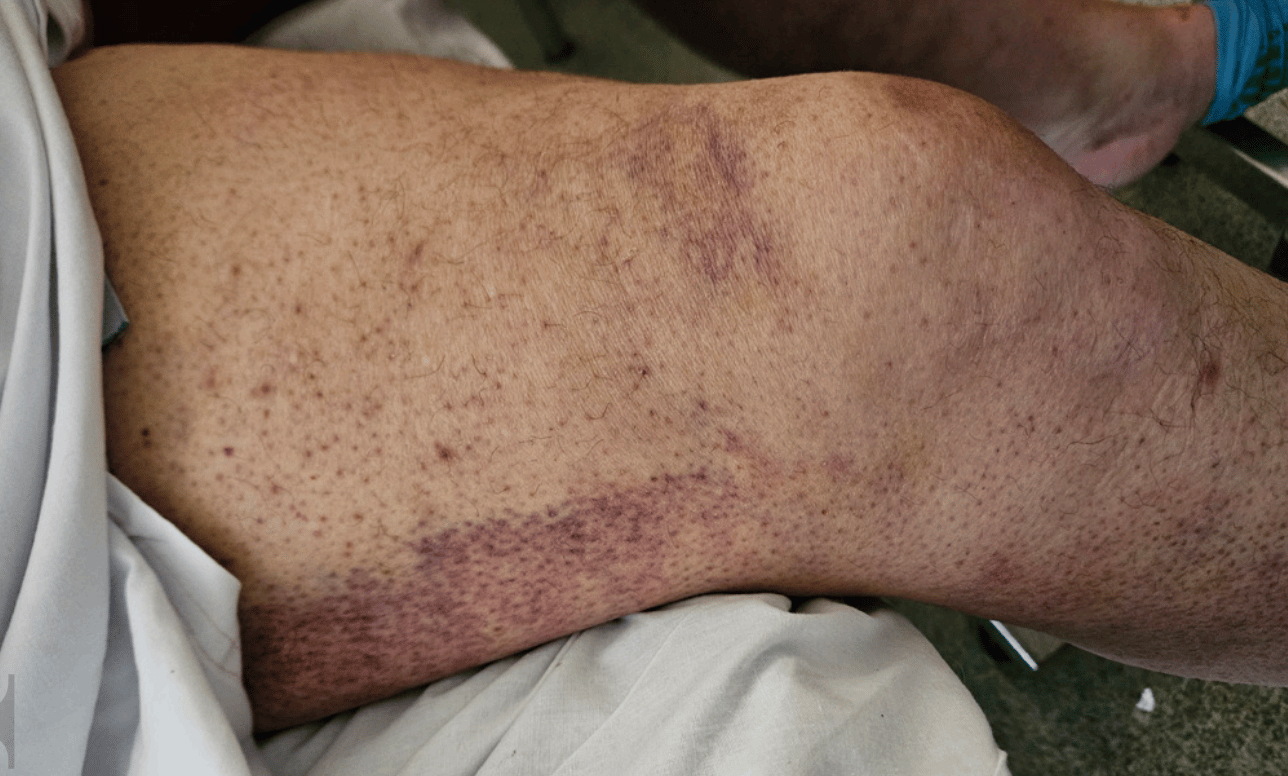A condition that killed millions of sailors between the 16th and 18th centuries has resurfaced, and looks set to become more prevalent in regions of the world you’d least expect to see it.
Scurvy, caused by a vitamin C deficiency, is back in the news following the hospital admission of a 51-year-old Australian man who presented with an acute case of the condition that, until recent years, has been rare in Western, industrialized countries.
The man turned up to Sir Charles Gairdner Hospital in the Western Australian capital of Perth with a painful rash on his legs that then spread across his body while he underwent a suite of tests to determine why his blood vessels had become so inflamed.

BMJ Case Reports
While the man also had blood in his urine and the telltale signs of anemia, extensive tests showed no evidence of autoimmune or blood disorders, or internal bleeding. And it wasn’t until he was questioned about his diet that it became evident his symptoms lined up with scurvy – a condition that may be making a resurgence in wealthy countries as more people experience cost-of-living pressures.
“Further history revealed that the patient’s living circumstances were poor,” the medical researchers noted. “He had financial constraints and therefore neglected his diet. His meals mostly comprised processed food, lacking in vegetables or fruit. Sometimes he would skip meals, which occurred more frequently in recent weeks. He had also stopped taking the vitamin and mineral supplements prescribed following gastric bypass surgery as he was unable to afford them. An underlying nutritional deficiency was therefore suspected.”
The patient ultimately recovered, following daily vitamin C (1,000 mg), vitamin D3, folic acid and multivitamin supplements, but scurvy can prove fatal if it’s left untreated. Because vitamin C is essential for wound healing, maintaining the immune system and bone regeneration, a poor diet for just a month can trigger the condition, with early warning signs including a painful rash, swelling of the legs, fatigue and increased bruising. It can then progress and prove fatal due to infection and bleeding.
While it killed millions of sailors many centuries ago, it’s been a rare occurrence in developed countries like the US and Australia. However, researchers believe scurvy is making a comeback due to dietary compromises that have resulted from the increased cost of living and a lack of affordable foods that are rich in vitamin C.
And US comedian Matt Storrs recently recounted his brush with scurvy as a college student.
@mtstorrs I was very dumb as a college freshman but it made for a story I’m so excited to share on @The Moth this week #story #scurvy #fypシ #collegelife #medicalmystery ♬ original sound – Matt Storrs
“In the human diet, 90% of vitamin C comes from citrus fruit and vegetables like sweet peppers, broccoli, cauliflower, and tomatoes,” noted researchers in a 2022 study. “Thermal treatment can decrease the vitamin C content of food. It takes 40-90 days of sustained hypovitaminosis C for overt scurvy to develop, but clinical manifestations can appear within 30 days of dietary insufficiency of vitamin C.”
While scurvy has never actually disappeared – at-risk populations include those with alcoholism or eating disorder issues, bariatric surgery patients and the elderly – researchers are concerned that this ‘Renaissance disease’ is beginning to have a much broader reach.
“Scurvy is still seen as a disease of the past, especially in developed countries,” the researchers noted.
In a July 2024 paper, US researchers found that cases of pediatric scurvy had tripled between 2016 and 2020. And within these figures, they discovered that those most at risk had other health conditions, including obesity and autism spectrum disorder, as well as a low socioeconomic status.
However, the good news is that scurvy is easy to combat and symptoms can be alleviated in as little as 24 hours. But the medical team that treated the 51-year-old Australian add that more awareness – among healthcare professionals and the general public – will ultimately save lives. And being mindful of the importance of vitamin C intake will help prevent the need for medical intervention.
“The treatment for scurvy is vitamin C supplementation,” they added. “In children, the recommendation is 100 mg of ascorbic acid three times daily for one week and then once daily for several weeks until they have fully recovered. Adults are treated with 300–1,000mg daily for one month. The response to vitamin C supplementation is often dramatic, as in our case. It is reported that even one replacement dose of vitamin C can stop gastrointestinal bleeding, and capillary stability is established within 24 hours. It may take up to two-to-three weeks for other symptoms, such as skin lesions, to heal.
“Clinicians should be aware of this fatal but easily curable condition that may still occur in this modern age,” they concluded.
The study was published in BMJ Case Reports.
Source: Sir Charles Gairdner Hospital via Scimex
